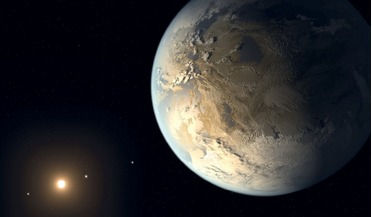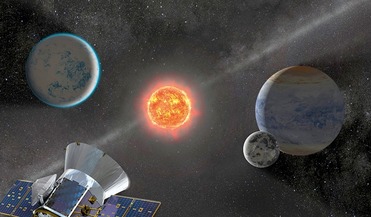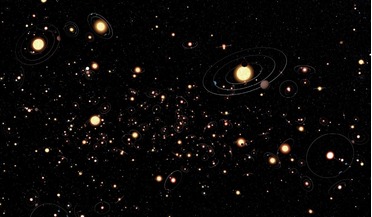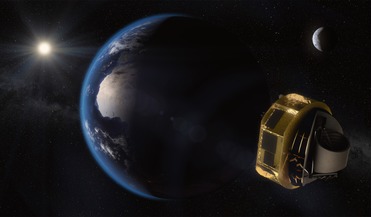ROOM: The Space Journal is one of the major magazines on space exploration, technology and industry. At ROOM, we share a common objective – promotion of peaceful space exploration for the benefit of humankind, all while bringing you incisive articles on a plethora of interesting topics. Our authors include academics and industry leaders from all over the world, which lets us bring you the newest and detailed information about nasa exoplanet science institute.
 August 2018
Exoplanet census promises radical discoveries
August 2018
Exoplanet census promises radical discoveries
... Earth-like planet is likely to depend on the planets in Jupiter-like orbits in the same system (the upcoming NASA TESS and ESA PLATO missions will discover planets with the transit method, but they focus... the combination of radial velocity, transits and microlensing have made possible tremendous advances in exoplanet science, it is only direct imaging that can characterise a planet’s atmosphere and can potentially search for biological indicators...
 January 2023
Private space stations and NASA’s effort to re-invent itself
January 2023
Private space stations and NASA’s effort to re-invent itself
... three teams are headed by Northrop Grumman (NGC), Blue Origin and Nanoracks. The idea is that NASA orbital science research activities will provide the anchor funding for these two private space stations and that... the creation of such a new international certification and safety research entity in his book - The Space Safety Institute: A New Way to Safety Certification in the NewSpace Age - while his recently released 21st Century Space Stations...
 April 2019
Scanning the skies for exoplanets
April 2019
Scanning the skies for exoplanets
... large. With thousands more worlds left to uncover, NASA has already dispatched a replacement to carry on where Kepler left off. Launched in April 2018, the Transiting Exoplanet Survey Satellite (TESS) is designed to search for ...probably has a rocky core surrounded by an atmosphere,” explained Diana Dragomir, a Hubble Fellow at the MIT Kavli Institute and lead author of a paper describing the find. Although that is notable in its own right, there ...
 November 2018
How many people does it take to colonise an exoplanet?
November 2018
How many people does it take to colonise an exoplanet?
...Located at 4.2 light years (40,000 billion km), Proxima Centauri b is almost an ideal destination - as far as exoplanets go. But while this distance may be small by astronomical standards, it remains utterly vast on the human scale. The...data in their research projects. Rhys Taylor is a postdoctoral researcher at the Astronomical Institute of the Czech Academy of Sciences in Prague. He specialises in radio astronomy and spent two years at the ...
 September 2017
Science searches for cosmic company
September 2017
Science searches for cosmic company
...aren’t like the Sun, the only star known to harbour a world with intelligence. But recent exoplanet studies have shown that a considerable fraction of these bantam suns have planets in the so-called ‘.... About the author Dr Seth Shostak is Senior Astronomer at the SETI Institute in Mountain View, California. He is also the host of ‘Big Picture Science’, the SETI Institute’s weekly radio show, and is committed to getting the public, especially...
 May 2018
PLATO the habitable zone explorer
May 2018
PLATO the habitable zone explorer
...predecessors. It will find thousands of planets, giving us a planetary census that builds on our knowledge from NASA’s Kepler, K2 and TESS space missions, and extending it in new directions that were previously inaccessible. ... magnitude more than have been examined previously. This has benefits beyond the obvious applications to exoplanet science, including improvements to our understanding of how stars rotate, what they look like inside, ...
 September 2023
The Institute of Biomedical Problems - Sixty years of contributing to the development of space biomedicine
September 2023
The Institute of Biomedical Problems - Sixty years of contributing to the development of space biomedicine
... space biology and medicine, laid the foundation for many years of cooperation under the Mir-NASA and Mir-Shuttle programmes, which later became the basis for research and experiments on the ...and is a Full Member of the International Academy of Astronautics (IAA) and a Head of Department at the Institute of Biomedical Problems of the Russian Academy of Sciences (IBMP RAS), Moscow, Russia. Anna R Kussmaul has a PhD in Biology and is a Full Member ...
 August 2017
Big science from small spacecraft
August 2017
Big science from small spacecraft
... provide a boost in velocity to propel them on their way to their primary mission target. NASA missions that have used this slingshot effect include Galileo (Jupiter), MESSENGER (Mercury), Cassini (Saturn),... mission concepts across Earth Science, Planetary Science and Astrophysics. He also teaches Aerospace Engineering (with a focus on nanosats), Systems Engineering and Program Management at the California Institute of Technology (Caltech). ...
 23 March 2018
ESA selects ARIEL to look closely at exoplanets
23 March 2018
ESA selects ARIEL to look closely at exoplanets
... star. ARIEL has been developed by a consortium of more than 60 institutes from 15 ESA member state countries, with UK institutions providing the leadership and planning for the mission. ARIEL’s Principal Investigator, ... a deep survey of their cloud systems. "ARIEL is a logical next step in exoplanet science, allowing us to progress on key science questions regarding their formation and evolution, while also helping us to understand Earth's place ...